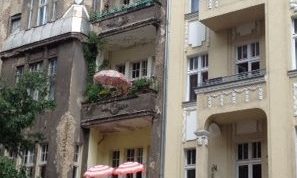Modernising or ruining a counter culture city?
As defined by the Oxford Dictionary:
Gentrification: verb (gentrifies, gentrifying, gentrified)
[with object]
renovate and improve (a house or district) so that it conforms to middle-class taste.
(usually as adjective gentrified) make (someone or their way of life) more genteel:a gentrified Irish American
Gentrification is the word on everyone’s lips in Berlin. It’s in the media every week. It’s bandied around by politicians and locals alike. It’s present at almost every dinner and party I’ve been to in the last year. So why is it suddenly so omnipresent?
I first came to Berlin in 2004. I moved to live here in 2005. Admittedly that’s nothing compared to someone who’s lived here their whole life. But it’s been nearly a decade. Long enough to settle in, learn the language and to bear witness to some remarkable changes here in the city. I can’t imagine how the life-long Berliners feel when they look around their city and the changes they’ve seen in their lifetimes. Everyone is complaining about major rental increases, entire neighbourhoods are changing so fast it’s hard to keep track of it all, and the older Berliners are seriously worried about how they will manage on their pensions if their rent doubles (a real possibility in some cases).
20 years ago Prenzlauerberg was a dump full of junkies and alcoholics. 10 years ago Prenzlauerberg was a hub for artists and creative types – it was close to the centre but cheap enough for people without much money. I first stayed with a friend of mine in one of the oldest renovated squats in East Berlin on Kastanienallee. This suburb is now one of the most expensive in Berlin and the street is now locally referred to as ‘Casting Alley’ because of the young beautiful hip things sipping lattes in the trendy cafes.
Friedrichshain was full of punks and students and it still felt a bit ‘edgy’ to me. 5 years ago everyone who could no longer afford to live in Prenzlauerberg moved to Friedrichshain. Now even that is too pricey.
Kreuzberg was the old bastion of long term west Berlin artists, squatters, social renovators and immigrants. Now it hosts the best Berlin fashion design store (as voted by Berlin Fashion week 2012) and a shop that sells 2500euro fold up bicycles.
The suburb Wedding was a scarey place, with many Turkish immigrants and some streets with a pretty high crime rate, full of 1960’s concrete housing blocks and betting shops. These days many smaller bars and designer places are relocating there, the old disused swimming pool has been turned into a funky location for perfomances and other offbeat art, and even one private english/german bilingual school is considering relocating to Wedding.
But nowhere does the change surprise me as much as in Neukölln. 13 years ago this was the place I first lived in Berlin. I shared a flat with a guy called Randy (no joke) and paid €180 a month, utilities included. It was (and still is) a major enclave for the Turkish immigrants in Berlin with more Turkish than German being heard on the streets and in the subways. It had (and still has) the highest percentage of families living on welfare. It is a major drug centre of Berlin. It was also a primary place for peadophiles to prey on young boys from poor families. The planes landing and taking off at the nearby Tempelhof airport made life pretty noisy.
But a nearly 10 years ago the airport closed and has subsequently become a massive open green space for public use, with community gardens, a bird sanctuary, a kids festival, a music festival, a kite festival, Berlin fashion week and much much more. And what has happened to Neu Kölln? I was down there a month or so ago and was overwhelmed at the speed of change in my old neighbourhood. It seems like almost every week something new opens up – a designer clothes shop, an organic bakery, a whole in the wall waffle shop that serves soy milk lattes, not to mention a couple of really damn good restaurants (when I lived there the Döner on the corner was the only option for a night out).
What has happened in Neu Kölln is that there is now the sense of a two tier society sharing the same suburb. The first is people who are genuinely poor, struggling with social issues or identify with the Turkish culture. The other consists of artists, foreigners, students, hipsters, start ups, trend followers and young entrepreneurs. And the people wanting to live in the funky neighbourhood these people create of course.
So what happened to the Turks, drug addicts and welfare cases?
They’re still there. For now.
